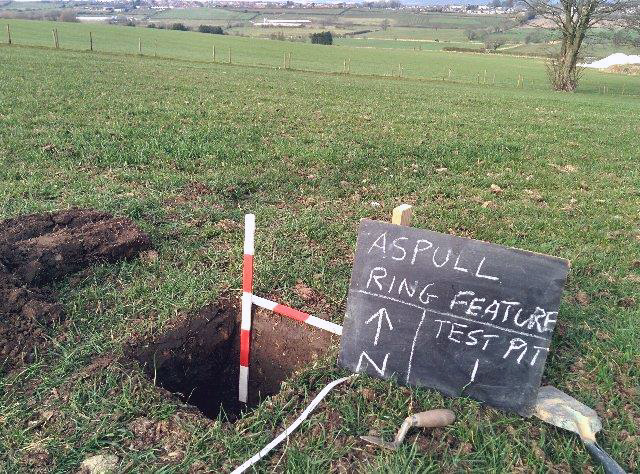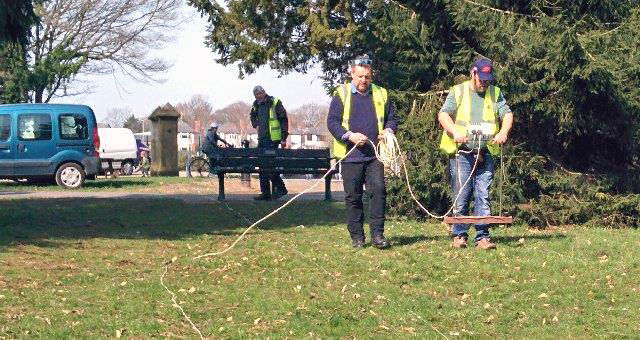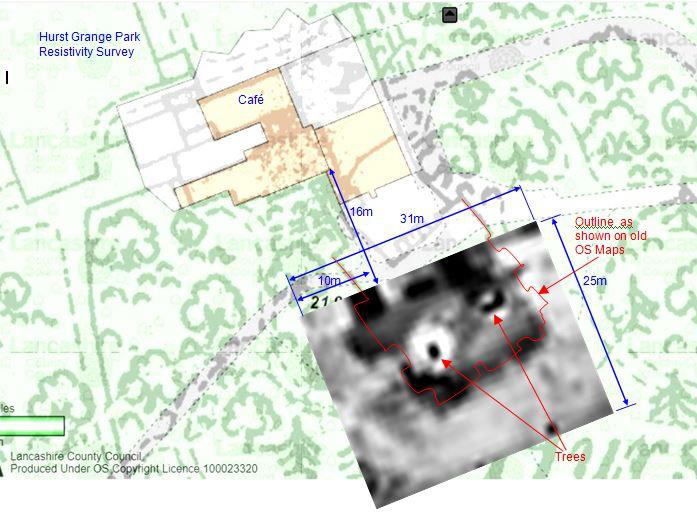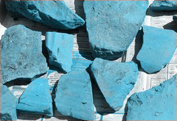
The March weather has been kind to us, so last month we were able to get out into the field to dig a couple of small test pits on this site. The work is inline with our Project Plan, which we developed at our first project meeting held just a couple of days before the visit. The idea was to find out how deep the topsoil is in the area to be excavated and so give us confidence in identifying the sub-soil when we encounter it. The farmer has kindly offered his excavator to remove the topsoil, which is great news as it will enable us to investigate a larger area than if we were doing it by hand. Our visit also gave us an opportunity to mark out our first trench, which we are hoping to open up early this month (weather depending). Our intention is to straddle the ditch feature, so we've located our trench in an area where the results of our geophysics and aerial crop marks coincide (as can be seen in Newsletter 246). We've decided to carry out our project in phases, this first phase being just to see if we can identify the ditch (if that's what it is). Later phases will allow us to investigate the depth of the ditch by putting a section through it and also look at other features identified on the geophys.
As you can see from our two test pits, which were located either side of the ditch feature, the topsoil is not very deep, i.e. between 25and 28cm. The change in colouration of the sub-soil is also very encouraging as the sample from the internal position was much darker. This is our first positive indication of an archaeological feature and gives us confidence we will be able to trace it on the ground. For those who have expressed an interest in getting involved, I will let everyone know as soon as possible when we will be starting the dig.
Hurst Grange Survey

Also last month were contacted by Peter Wilkinson, of the Friends of Hurst Grange Park, to see if we could locate the position of the old mansion with a resistivity survey. The Park is the largest in Penwortham and has recently received a large grant from the Nation Lottery to restore it to its former glory. It was once the home of Lancashire judge, William Adam Hulton, who built a large house, including coach house and stables and laid out the landscaped parkland in 1848. The house was demolished in the 1930s but the coach house was retained and has now been converted into a very nice café and heritage centre. There is no sign now of where the house was and so it was our job to see if we could locate its footprint. Old OS maps enabled us to roughly locate where to put in our survey and despite the trees we were able to carry out a 25m x 31m scan. The result was very successful (see below) as the footprint of the house showed up quite clearly, matching the outline shown on the old maps fairly closely. This confirmed that much of its foundations have survived and Peter has now confidence in excavating a section which he has asked the Wyre Group to carry out. This will determine the level of preservation and therefore how much they may be able to leave on show.

Latest from Burscough
In the summer of 2020, the Roman fort site at Burscough was scheduled (as reported in Newsletter 235). This was precipitated after an incursion by Steve Baldwin's neighbour on to his land, seeking to build a caravan park on it. She was claiming the 12m strip of land was hers, after the dividing fence was put in the wrong place when the fields were sold off in 2006. A recent court ruling has now landed in Steve's favour, confirming the original fence line to be correct (details on Facebook). This is great news as Steve can now carry on with his excavations in that area, which had been put on hold until the dispute was settled (pending Scheduled Monument approval of course). Steve is planning a dig to assess the damage done by the excavator, so I'll keep those interested up to date when this is likely to take place.
Next Meeting
Wednesday 6th April - in our new venue, the Real Crafty on Upper Dicconson Street (7.30pm as usual). This month we will be having Norman Redhead, who retired last year as head of the Greater Manchester Archaeological Advisory Service. Since then, Norman has been concentrating on working with the Friends of Castleshaw Roman Fort and last summer the Friends returned to the site to carry out more excavations. Norman will be reporting on the findings. With its additional fortlet the fort at Castleshaw is very significant to us as it reflects a similar pattern of development to the fort at Burscough. Hope to see you there B.A.
|



